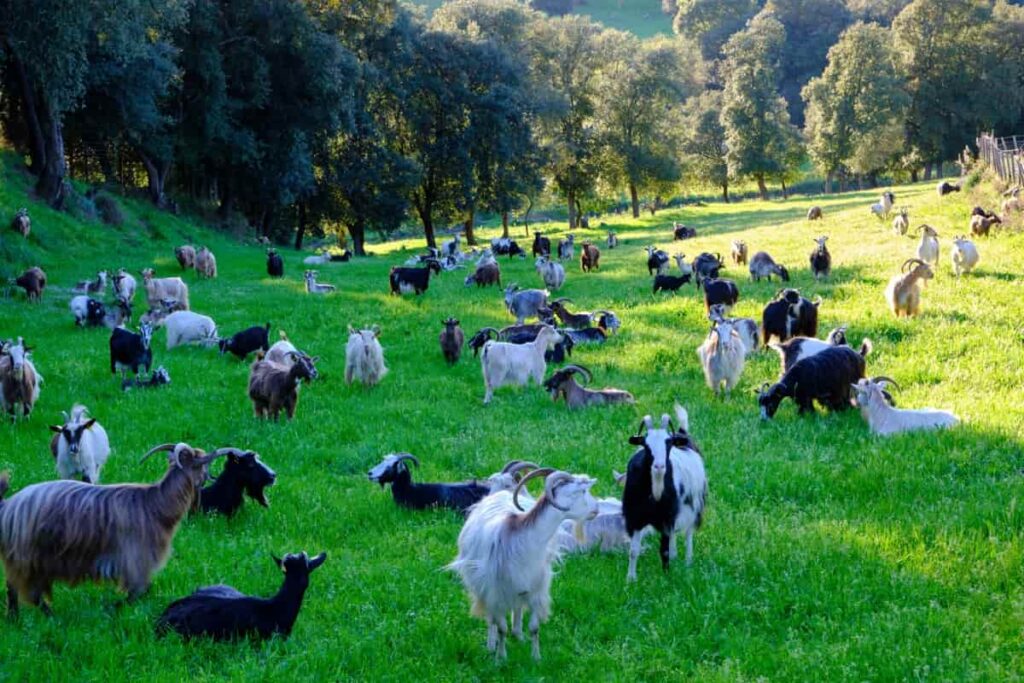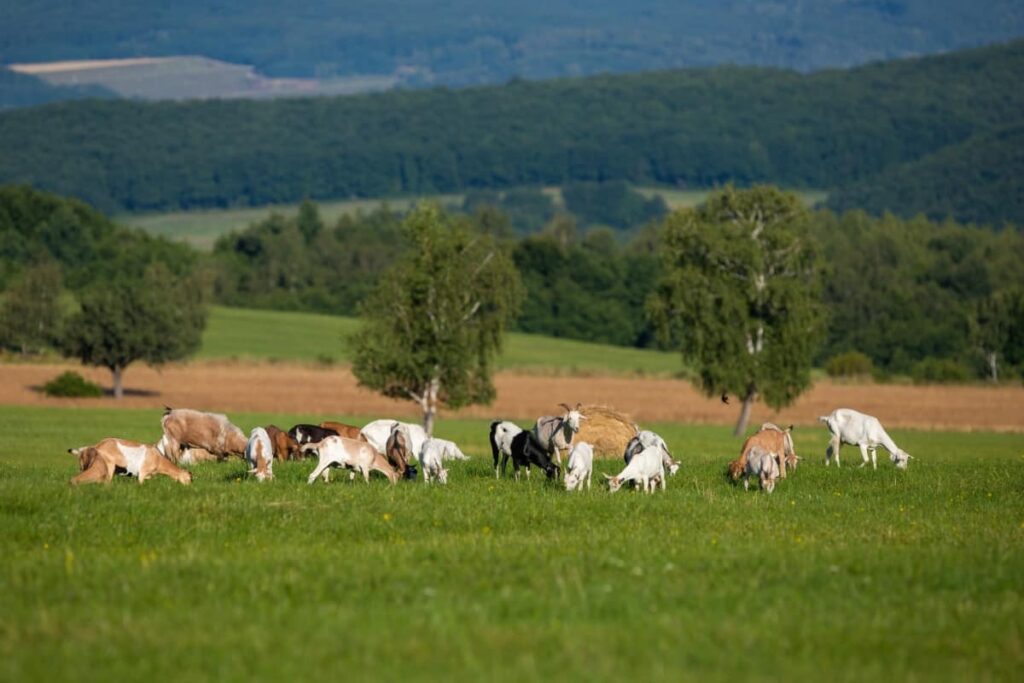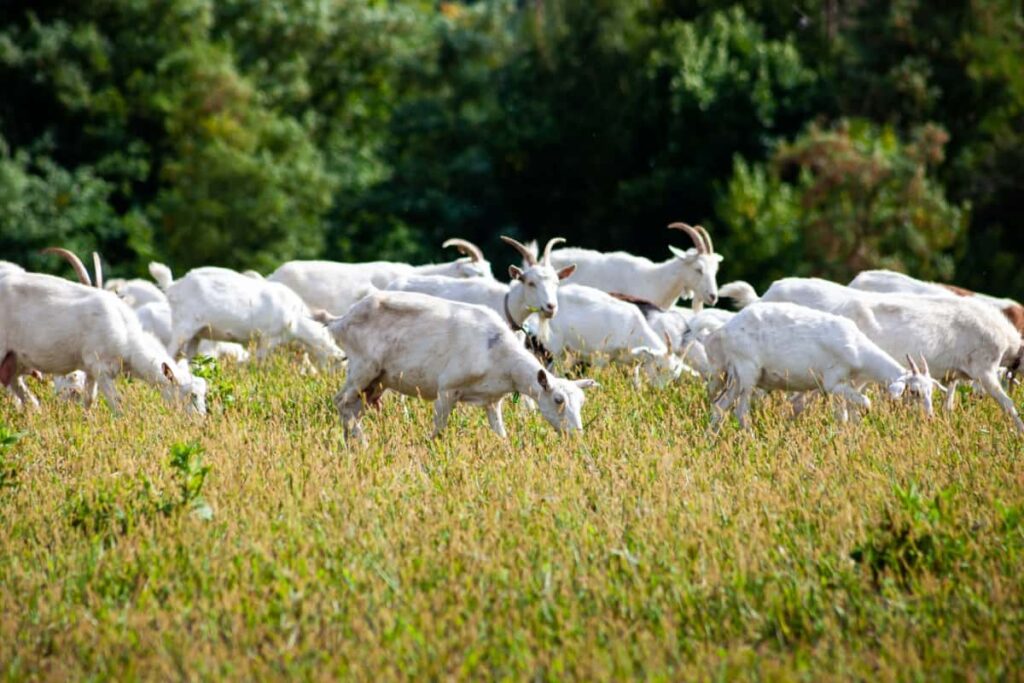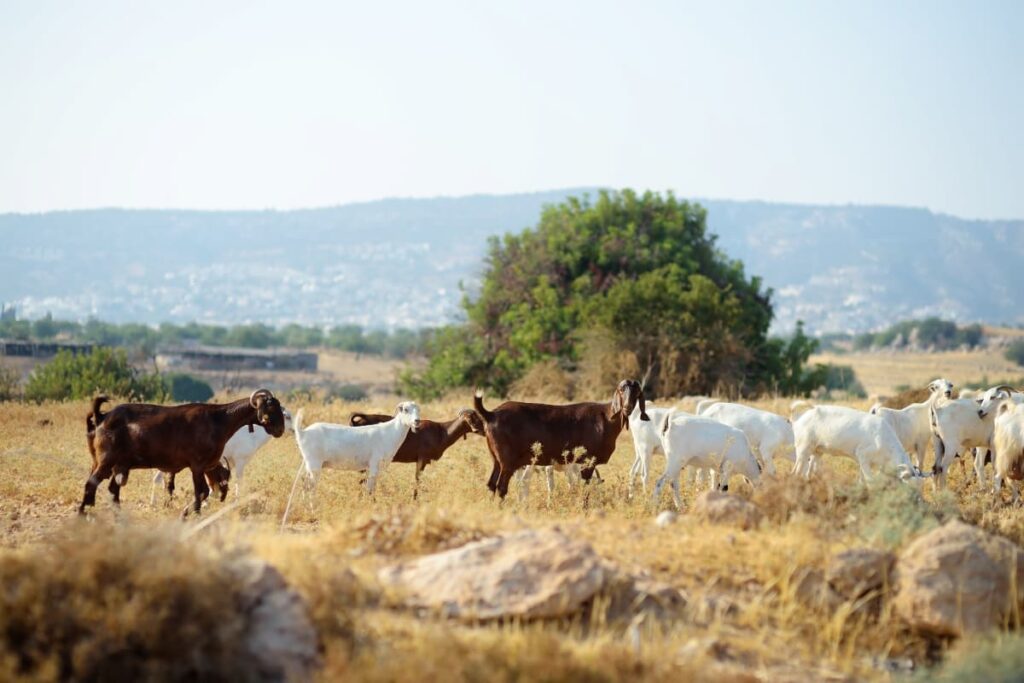Land clearing and vegetation management in goats refers to the practice of utilizing these animals to control and maintain the growth of plants on a piece of land. Goats have long been recognized as efficient and eco-friendly land-clearing machines. Their ability to consume vegetation makes them invaluable in the field of land clearing and vegetation management.

How to Utilize Goats for Land Clearing
Benefits of Using Goats for Land Clearing and Vegetation Management
The main advantage is their ability to graze on a variety of plant species, including tough and invasive weeds that can be challenging to eradicate through other methods. Goats are environmentally friendly and do not contribute to soil erosion or water pollution. They naturally fertilize the land as they graze, providing nutrients that promote healthy plant growth.
Using goats for land clearing also reduces the need for manual labor or expensive equipment. Moreover, goats are cost-effective when compared to alternative methods of vegetation management. Their low maintenance requirements make them an affordable long-term solution for ongoing land maintenance projects.
Selecting the Right Breeds of Goats for Effective Vegetation Management
Different goat breeds have varying grazing preferences and abilities, so choosing the appropriate breed will ensure optimal results in clearing land and managing vegetation. The popular goat breed for vegetation management is the Boer goat. Known for their excellent foraging abilities, these goats are efficient at eating brush, weeds, and grasses.
Another suitable breed is the Kiko goat. Their hardiness and resistance to diseases make them an ideal choice for sustainable land clearing projects. For areas with dense woody vegetation or invasive plants like honeysuckle or kudzu, Spanish goats may be more suitable due to their preference for browsing over grasses. When selecting goat breeds, it’s important to consider factors such as climate compatibility, terrain adaptability, desired level of aggression towards unwanted plant species (some breeds are more aggressive grazers), and availability in your area.
Creating a Sustainable Grazing Plan for Goats in Land Clearing Projects
To start, it’s important to assess the size and condition of the area that needs to be cleared. This will help determine how many goats are needed and how long they should graze in each section. Next, consider the types of vegetation present on your land. Different breeds of goats have preferences when it comes to what they eat, so selecting the right breed is key.
In case you missed it: Goat Farm Infrastructure: How to Design Efficient Facilities

Some may prefer grasses, while others excel at browsing shrubs and woody plants. Implementing rotational grazing techniques is another important aspect of a sustainable plan. By dividing your land into sections or paddocks, you allow time for vegetation regrowth while also ensuring that all areas receive equal attention from the goats.
Implementing Rotational Grazing Techniques for Maximum Vegetation Control
It is a highly effective strategy for maximizing vegetation control with goats. This method involves dividing the land into designated grazing areas and rotating the goats between them on a regular basis. By implementing rotational grazing, you allow the goats to graze in one area while giving other sections time to recover and regrow.
Rotational grazing helps maintain a balanced ecosystem by promoting biodiversity and preventing the dominance of certain plant species. It ensures that all areas receive equal attention from the goats, minimizing the risk of uneven clearing or neglecting certain portions of land. Additionally, this technique helps prevent soil erosion as well as build soil fertility through natural fertilization from goat droppings.
Utilizing Goats to Manage Invasive Plant Species and Weeds
They have a natural inclination to browse undesirable vegetation, seeking out those tasty leaves and stems that other animals might ignore. This makes them incredibly effective at reducing the spread of invasive plants. In addition to their impressive eating habits, goats also possess specialized digestive systems that allow them to break down toxic compounds found in some invasive plants.
This means they can safely graze on certain species that could be harmful or even deadly to other animals. It’s important to note that utilizing goats for managing invasive plant species requires careful planning and monitoring. Not all goat breeds are equally adept at this task; selecting breeds known for their browsing abilities will yield better results.
Integrating Goats into Erosion Control and Soil Stabilization Efforts
Goats are natural climbers and agile grazers, which means they can access hard-to-reach areas that machinery or humans may struggle with. Their hooves help aerate the soil while their browsing behavior controls plant growth, reducing the risk of erosion caused by excessive runoff.
By strategically placing goats in areas prone to erosion or unstable soils, you can effectively manage these issues without resorting to expensive or environmentally harmful methods. It’s important to note that integrating goats into erosion control efforts requires careful planning. Regular monitoring of goat health becomes essential when integrating them into erosion control projects.
Establishing Proper Fencing and Enclosures for Grazing Goats
The first step in setting up the perfect goat enclosure is selecting the right type of fencing. A sturdy fence that is at least four feet high can help keep your furry friends contained while preventing them from escaping or predators from entering. Consider using woven wire or electric fencing for added security.
Another important consideration when setting up enclosures for grazing goats is providing adequate shelter. Regular maintenance of fences and enclosures is essential to ensure their effectiveness over time. Inspect fences regularly for damage and repair any weak spots promptly to prevent potential escapes or intrusions by unwanted visitors.
Monitoring the Health and Well-Being of Grazing Goats
Regular veterinary check-ups are vital for monitoring the general health of the goats. This includes vaccinations, deworming, hoof trimming, and dental care. By staying on top of these routine tasks, you can prevent the development of diseases or complications that could hinder their ability to graze effectively.
In case you missed it: 10 Spring Transition Tips to Keep Your Goats Happy

In addition to regular veterinary care, observing the behavior and physical appearance of the goats is important. Keep an eye out for signs of illness or distress, such as changes in appetite, weight loss, abnormal discharge, coughing, or lameness. Promptly addressing any abnormalities can help prevent further deterioration of their health. Maintaining appropriate grazing areas is essential for preventing overgrazing and promoting sustainable vegetation management.
Incorporating Goats into Integrated Pest Management Strategies for Vegetation Control
The key advantage of using goats is their selective feeding habits. Unlike mechanical equipment or herbicides that may harm desirable plants along with unwanted ones, goats have a knack for munching on specific species that pose a threat to native vegetation. They are particularly effective at targeting woody brush, thorny shrubs, and even some poisonous weeds that other animals would avoid.
Another benefit of incorporating goats into integrated pest management strategies is their ability to access hard-to-reach areas. Their agility allows them to navigate steep slopes, rocky terrain, and densely overgrown spaces where human labor or machinery may struggle. This makes them an ideal choice for controlling vegetation in challenging landscapes such as hillsides or remote areas.
Evaluating the Economic and Environmental Effect of Using Goats for Land Clearing
From an environmental perspective, using goats for land clearing reduces the need for harmful chemicals or heavy machinery that can damage ecosystems. Goats are natural grazers and have a unique ability to target specific plant species without harming beneficial ones. This targeted approach helps preserve biodiversity while effectively managing invasive plants and weeds. Furthermore, goat browsing results in reduced fuel consumption since there’s no need for machinery or transportation associated with conventional methods.
Frequently Asked Questions on Using Goats for Land Clearing and Vegetation
Are Goats Effective in Clearing Land and Managing Vegetation?
Absolutely. Goats have an incredible appetite for all vegetation types, including brush, weeds, and even poison ivy. They can navigate rough terrain and reach areas machinery or humans may struggle to access. Plus, their grazing habits help promote the regrowth of desired plants by naturally pruning and fertilizing the land.
How Many Goats Do I Need to Clear My Property Effectively?
The number of goats required depends on the size of your land and the density of vegetation you want them to clear. Generally, about 10-15 goats per acre are recommended for efficient land clearing.
Can I Use Any Goat for Land Clearing?
While all goats have some degree of browsing capability, certain breeds are more adept at vegetation management than others. Meat breeds like Boer or Kiko goats are known for their larger size and hearty appetites, making them excellent choices for intensive grazing projects.
In case you missed it: How to Build a Cheap Goat Fence on Your Budget: DYI Tips

Conclusion
Land clearing and vegetation management through goat grazing is an eco-friendly alternative that ensures effective control over unwanted plant growth while preserving the balance of nature. Regular veterinary care should be provided along with a proper diet to ensure their well-being and maximize their potential as vegetation managers.
- Types of Grass Growing for Goat Farm
- How to Train Goats for Milking: A Beginners Guide
- Goat Milking Practices and Equipment: A Beginner’s Guide
- Goat Farming for Fiber: Producing Mohair and Cashmere
- Maximizing Goat Milk Production: Tips for Dairy Goat Farmers
- Goat Farming as a Family Business: Strategies for Success
- Profitable Kenya Goat Breeds for Commercial Dairy and Meat Business
- Unlock the Secrets of Oberhasli Goat: Discover Raising and Management Practices
- Ultimate Guide to Myotonic Goats: Explore Profile to Raising